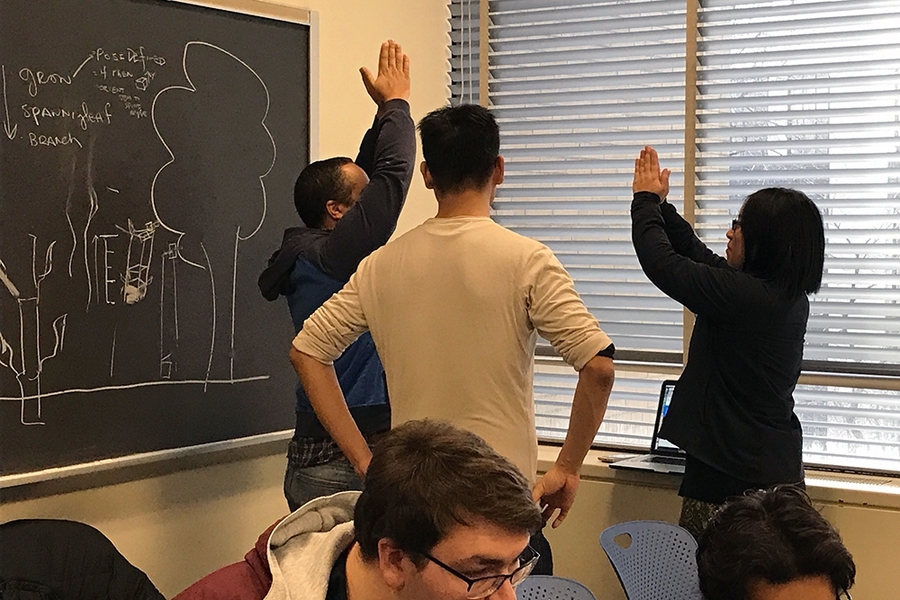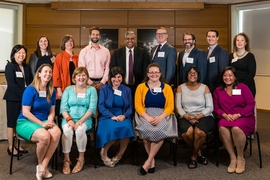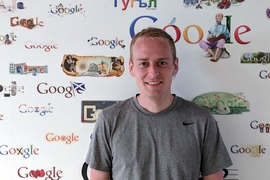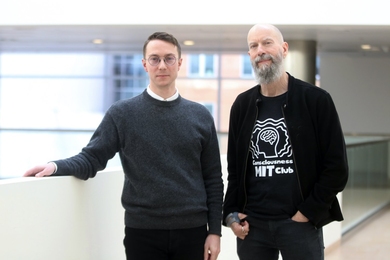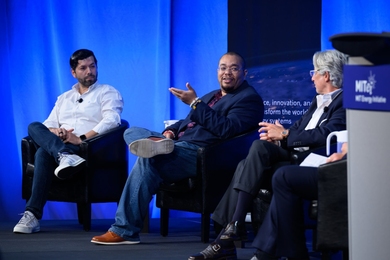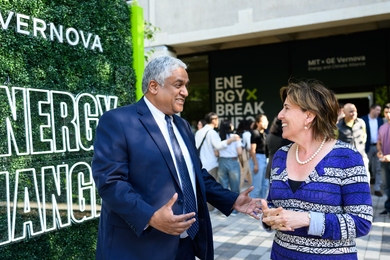If you get the chance to talk with MIT Lecturer Kyle Keane or his colleague Andrew Ringler about their course, RES.3-003 (Learn to Build Your Own Videogame with Unity Game Engine and Microsoft Kinect), you probably won’t discuss technology much — if at all. Instead, be prepared to hear terms like: behavioral modeling, emotional intelligence, vulnerability, and positive psychology. Keane, this year's recipient of the MIT School of Engineering Infinite Mile Award for Excellence and the James N. Murphy Award for inspired and dedicated service to students, delivers a rigorous project-based curriculum, where he and Ringler consciously employ positive education techniques to create a kinder, bolder, and more effective learning experience.
In this nine-day hands-on workshop about scientific communication and public engagement, students learn to design, build, and publish video games using the Unity game engine. Students also gain experience in collaborative software development with GitHub, gesture-based human-computer interactions using Microsoft Kinect, automation and robotics using Arduino, as well as 3-D digital object creation, video game design, and small-team management. What makes this workshop special is the care with which each technical activity has been paired with fundamental soft skills to help students thrive as they enter the workforce of the modern network economy.
The keystone of their approach, as described in their MIT xTalk, is the particular combination of project-based curriculum, collaborative learning, and positive education they employ to break down barriers between students, encourage participation, and create an environment where vulnerability becomes possible. Collaborative learning is a well-established pedagogical framework that centers around small groups engaging in interdependent learning activities. In this workshop, the activities are scaffolded to culminate in an open-ended real-world project. Keane and Ringler have found that in a safe learning environment, the vulnerability experienced during collaborative learning can enable students to overcome the fear of failure and foster creative exploration.
“To create a safe environment and encourage vulnerability, we use training techniques adapted from Improv comedy theater training, especially group warmup games,” said Ringler. “Often the comedic moment in Improv happens when a performer fails to meet an expectation, thus creating surprise and laughter. In Improv, the vulnerable moment of publicly making a mistake is reframed as a positive comedic moment. Improv games are designed to be easy to learn and to foster rapid mistake-making. We use these games to prime collaboration, nurture mistake-making, and encourage students to positively support each other in recovering from their mistakes.”
The workshop begins with an introduction to the course technology through a series of online tutorials. The goal of this first stage is to train students in the skills required to be self-sufficient learners who can continue exploring video game development long after the workshop is over. An instructor models the software with a live demo, while students reproduce the same tasks on their own computers to better internalize the experiential lesson. The explicit goal of this exercise is to provide hands-on software training, but the unspoken objective is for the instructor to teach students how to ask for assistance and be comfortable doing so in a public setting. Instructors will model confusion and resolution as they demonstrate the learning process that a novice is likely to take.
The next stage of the workshop is where collaborative learning begins. The class works in small groups to complete a full tutorial, and instructors continue to focus on behavioral modeling. Students are taught how to openly ask questions of each other and to work together with kindness, acceptance, and a shared desire for everyone to learn the lessons of the tutorial. Instructors, meanwhile, model collaborative behaviors and foster patience, tolerance, and acceptance.
Through the practice of learning to collaborate with others, students will implicitly learn to collaborate with themselves; this is a fundamental skill as students transition into the next stage of the workshop, where they creatively expand on the tutorials by individually modifying what they’ve created with their group. During this stage, Keane and Ringler emphasize the importance of redefining creativity by encouraging students to express their own ideas by building upon existing work. Keane believes it is vital to explicitly let students know that “creativity is not always about coming up with completely original ideas. It is more important to learn to push the boundaries of our abilities by expressing ourselves through extension and modification. Mastery and fluency come with practice,” said Keane.
Mind-wandering and interleaving are two additional techniques employed in the workshop’s design. Students are encouraged to embrace mind-wandering, which is often framed in a negative light, like daydreaming, but is a natural cognitive state that fosters big-picture and creative thinking. Research has shown that mind-wandering is helpful for problem-solving when used in a structured way, and anecdotally, it is often credited for facilitating breakthrough ideas. Interleaving is a technique in which students learn multiple skills in parallel by alternating between them. When used appropriately, interleaving has been shown to improve comprehension, prolong retention and enable students to more effectively apply the knowledge they have gained.
“One important technique when learning a new technology is to take something that already works and spend a few minutes tweaking it,” said Ringler. “By changing the values of a few variables, a student can take an existing video game and begin transforming it into something new. When done openly and respectfully, many fields of study and self-expression view this process of appropriation as a valuable form of creativity. By adapting existing games at the start of the course, we encourage a culture of sharing and empower students by placing this form of creative expression within reach.”
“Our personal goal is to provide an opportunity for students to experience a fearless form of creativity that enables them to exceed their perceived limitations,” said Keane. “In the context of our class, success means failing. When we create an environment where failing is not only acceptable, but is expected, we can be creative, try things we otherwise wouldn’t, discover the boundaries of our skills, and learn much more than if we’d worked within our known capabilities.”
The origins of this workshop can be traced to an interactive art installation that was conceptualized by Professor W. Craig Carter in the MIT Department of Materials Science and Engineering. The installation was designed to share his passion for scientific computing and simulation with the public in a more tangible way. Mark Vrablic, an MIT undergraduate, spent a year working in the Interactive Materials Education Laboratory to bring Carter’s vision to life. “Mark’s interactive art installation grew into the digital framework that eventually became the foundation of the workshop,” said Keane. “None of this would have happened without Mark’s drive and creative dedication.” What started as an idea to help people more tangibly engage in scientific simulations became a resource that enabled people to create them for themselves. Eventually, Vrablic and visiting student Abhinav Gandhi helped design, teach, and document the Unity workshop on MIT OpenCourseWare.
“At MIT, we often work in groups to manage the heavy workload, but there is more pressure to avoid failure as part of a team than in any other setting because you know that people are counting on you to deliver,” said Vrablic. “So, while I’ve abandoned personal projects that turned out to be far more complex than I expected, I've never failed on a team. The idea of embracing failure on a team was totally foreign to me. Ironically, I found it was an incredibly powerful method of learning, and the lessons have stuck with me as I’ve moved on to new challenges and more advanced curriculum.”
Keane’s pedagogy embraces seemingly soft terms, such as vulnerability, not so he and his students can make light of difficult technical topics, but so they can push themselves, and each other, to the limits of their emotional and intellectual capabilities. Knowing that they are averse to failure, Keane has his students engage with problems that are bigger and more complex than they can possibly solve — and doing so requires them to ardently engage the curriculum. Importantly though, students are told from the very start that they are expected to stretch beyond their limits and fail and that they will not be punished for failing as long as they have demonstrated persistent effort.
This summer, with the support of MIT-India, Keane, Ringler, Vrablic, and Gandhi have partnered with an Indian EdTech startup called The Climber to bring this same teaching philosophy to Chennai, India; there, they’ll run a workshop that teaches students to design, prototype, and support assistive technologies for people with disabilities. Keane says, “It is a dream come true to combine my love of education with my passion for disability advocacy. I am honored to have the opportunity to combine the humanistic pedagogy of our workshops with Professor Seth Teller’s legacy of assistive technology at MIT.”

